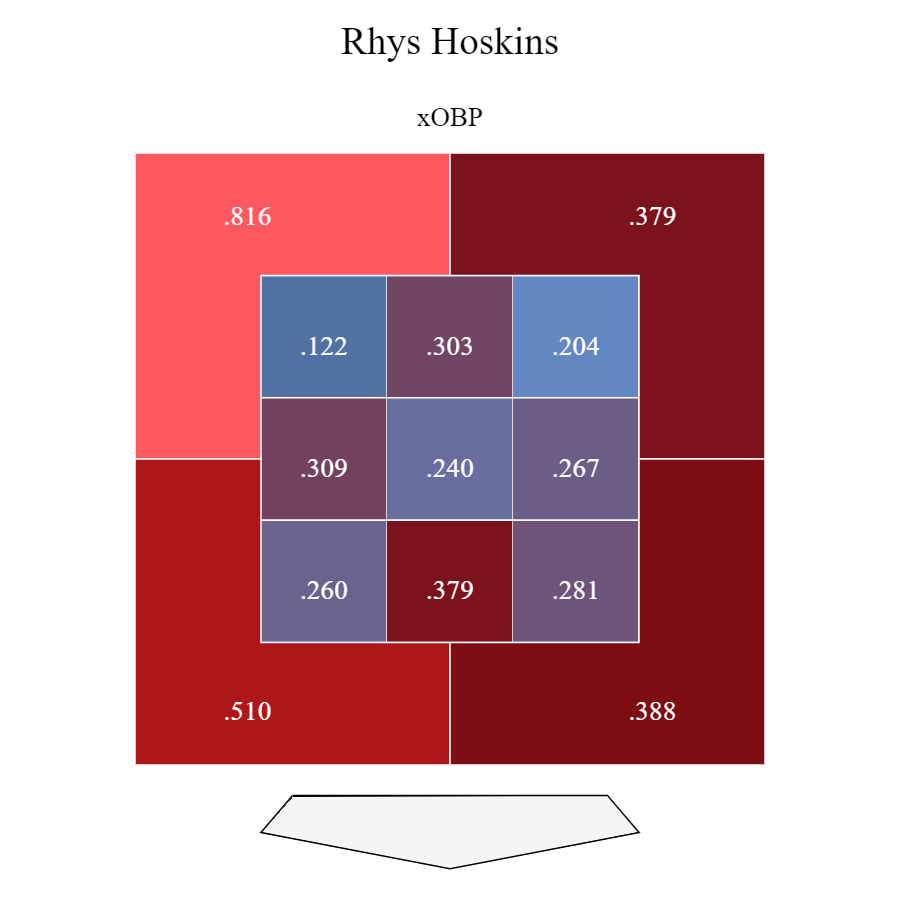In August of 2017, Rhys Hoskins got called up and simply put, he raked. In 212 plate appearances, he averaged .259, went yard 18 times, had an isolated power of .359, slugged .618, had a wOBA of .417, and had an average exit velocity of 90.9 mph. Sure, he played less than a third of a season, but that’s not going to stop Phillies fans from believing that they had a super slugger in their hands during the rebuild. The best part about it all, was that according to Baseball Savant’s expected metrics, he wasn’t even drastically overperforming. With an xBA of .259, xSLG of .564, and xwOBA of .403, the Phillies had a reason to think that if he continues his approach at the plate, we can continue to expect this for years to come.
Rhys found to find that 2017 form in this hectic 2020 season but fans and analysts have expressed their frustration in the first basemen, even suggesting trading him for an arm. Before we can look at his production in this season, it’s important to evaluate what he’s done in his two full major league seasons to truly gauge what he does at the plate.
In Rhys’ first full season in the majors, the guy slashed .246/.354/.496, dropped to a .363 wOBA and 128 wRC+, and even hit the ball less hard as he did the year prior with a 88.9 mph exit velocity. Regression is probably expected because clobbering the baseball almost every other plate appearance is hard to maintain. In 2019, we saw more of the same.
Despite the 27-year-old not being an incredible super slugger, he’s still valuable to the Phillies. There’s one thing that hasn’t changed from year to year, despite the output — his plate discipline.
Hoskins at the plate has always been really cautious, really looking for a favorable pitch to swing at. In 2019, he only swung at 61.0% of pitches that were in the strikezone, 7.5% less than the MLB average. However, he did make contact 84% of the time when he would swing at pitches in the zone, so he is at least putting the pitches he likes in play. What’s more impressive, his how well he sees the ball outside of the zone. Compared to the league average of 31.6%, Rhys only swung outside of the zone 24.0% of the time. That discipline is also the reason why he’s made contact on pitches outside of the zone 68.0% of the time, vs. the 62.7% the rest of the league has hit. It’s no surprise that his walk rate in 2019 was in the top 2% of all qualified batters, reaching first in 16.5% of plate appearances in that regard.
2019 is also the first season that Baseball Savant started valuing runs via swings on pitches in 4 zones; the heart of the plate, the shadow of the strikezone, pitches hitters would generally chase, and pitches way out of the strikezone, aka waste pitches. Hoskins had a run value of +13, which is doubled the league average. When it came to chase pitches, he had a run value of +33 which is where he stands out. He is not the hardest guy to strike out, but if you are going to put him away, you’ll have to throw strikes, which leads to his downside. Due to his natural tendency to lay off pitches, he had a -34 run value on pitches in the heart of the plate. Given that’s where most hitters do damage as a result of pitchers missing their spot, you would expect him to do the same. However, that isn’t the case and can be a little frustrating.

If you compare that to his xOBP, you can see a trend.

While we do know Rhys can do some damage when making contact, that isn’t the fundamental part of his game. In the past two seasons, while putting up some decent numbers per run production metrics (wRC+, wOBA, etc.), his value at the plate comes more from taking pitches for balls and getting on base as opposed to driving the ball deep, even though his triple slash might suggest him being a power hitter.
Now, let’s take Hoskins’ plate discipline, but he takes a few more swings that drives the ball the gap in the outfield or even over the wall. That’s what we saw more of. A +9 run value this season, Hoskins was only a -6 in pitches that were in the heart of the strike zone compared to the -34 from last season, as well as a +6 in pitches that shadowed the strike zone compared to his -3 last season. Not only that, but the quality of his hitting improved as well. His barrel % went up to 14.8% which puts him in the 93rd percentile, his line drive % went up to 27.8%, and he’s gotten under the ball 3% less, creating less pop ups in the process.
He slashed .245/.384/.503, overperforming his xBA by seven points and underperforming his xSLG by nine, had a wOBA of .382 vs. an xwOBA of .368, a wRC+ of 139, and an OPS of .887. This isn’t 2017 good but it’s pretty close. Hoskins started to go on a tear towards the latter stage of the season before it was cut short by a strained left elbow he’d eventually get surgery on. His swing may need to be refined, but regardless if we’ll see the same power on display when he isn’t taking pitches, the foundation of his game will remain and his getting on-base skills will see himself through the new transition.
Graphics and Stats via Baseball Savant and FanGraphs
Featured Image via Yong Kim of The Philadelphia Inquirer
